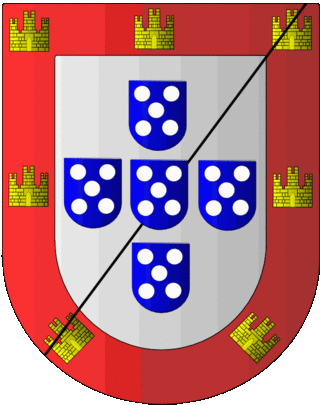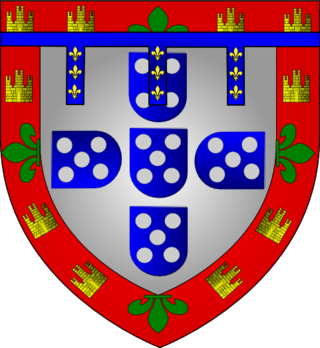Bibliography
- ”Nobreza de Portugal e do Brasil” – Vol. III, pages 527. Published by Zairol Lda., Lisbon 1989.
Manuel of Menezes (born c. 1530) was the second son of Pedro de Menezes (in English, Peter (III) of Menezes) 5th Marquis of Vila Real and of his wife, Beatrice of Lara (daughter of Afonso, 8th Constable of Portugal).
Initially, he was baptized Manuel of Noronha, but when his older brother (the 4th Marquis of Vila Real) died unexpectedly without issue in 1564, he inherited his house and changed his family name from Noronha to Menezes, once this was the name used by the Heads of the House of Vila Real.
He inherited all titles and honours, becoming 5th Marquis of Vila Real as well as all the subsidiary titles of this House: 7th Count of Vila Real, 4th Count of Alcoutim, 5th Count of Valença and 7th Governor of Ceuta.
When King Sebastian of Portugal visited for the first time Ceuta, Dom Manuel, as Governor of the city, received the monarch with extreme magnificence.
In recognition of his strong support during the 1580 Portuguese succession crisis, Philip I of Portugal rewarded him the new title of Duke of Vila Real , on 28 February 1585.
He married D. Maria da Silva (granddaughter of the 2nd Count of Redondo), a chamberlady of Queen Catherine of Austria, wife of King John III of Portugal.
They had 8 children:
Menezes, sometimes Meneses, was originally a Portuguese toponymic surname which originated in Montes Torozos, a region in Tierra de Campos, northeast of Valladolid and southeast of Palencia. The ancestor of the Meneses lineage was Tello Pérez de Meneses. The family wealth and power grew remarkably in the 13th and 14th centuries, through several marriages with the Castilian and Portuguese royal families.
The highest hereditary title in the Portuguese nobility. By tradition, there are a total of five royal and seven non-royal dukes in Portugal, out of 28 dukedoms that have ever been created. In the majority of cases, the title of duke was attributed to members of the high nobility, usually relatives of the Portuguese royal family, such as the second son of a monarch.

Beatrice of Silva, born Beatriz de Menezes da Silva, was a Portuguese noblewoman who became the foundress of the monastic Order of the Immaculate Conception. Amadeus of Portugal's younger sister, she is honored as a saint by the Roman Catholic Church.

The title duke of Terceira, de juro e herdade was created by decree of King Pedro IV of Portugal, on 8 November 1832. António José de Souza Manoel de Menezes Severim de Noronha, 7th Count of Vila Flor, de juro e herdade, and 1st Marquis of Vila Flor, was the first holder of the title.

Count of Linhares was a Portuguese title of nobility created by a royal decree of king John III of Portugal dated from May 13th, 1532, and granted to Dom António de Noronha, 2nd son of Pedro de Menezes, 1st Marquis of Vila Real.

Duke of Caminha was a title created by royal decree, dated 14 December 1620, by King Philip III of Portugal for Dom Miguel Luís de Menezes, 6th Marquis of Vila Real and 8th Count of Vila Real. He was the eldest son of Manuel de Menezes, Duke of Vila Real.

Duke of Vila Real was a Portuguese title of nobility created by royal decree, dated from February 28, 1585, by King Philip I of Portugal, and granted to Dom Manuel de Menezes, 5th Marquis of Vila Real and 7th Count of Vila Real.

Marquis of Vila Real was a Portuguese title of nobility created by a royal decree, dated from 1 March 1489, by King John II of Portugal, and granted to Dom Pedro de Menezes, also known as Peter II of Menezes, 3rd Count of Vila Real.

João de Lencastre, was the older son of Jorge de Lencastre, Duke of Coimbra and of his wife Dona Beatriz of Vilhena.

Infante Diogo of Viseu (1450–1484) was the second son of Ferdinand, Duke of Viseu, and his wife Beatriz, Duchess of Viseu.

Count of Ourém is a Portuguese title granted in 1370 by King Fernando I of Portugal, to Dom João Afonso Telo, uncle of Queen Leonor Teles. Later he also became the fourth Count of Barcelos.

Count of Alcoutim was a Portuguese title of nobility, subsidiary to the one of Marquis of Vila Real, created by a royal decree, dated from November 15, 1496, by King John II of Portugal, and granted to Dom Fernando de Menezes, also known as Ferdinand II of Menezes, 2nd Marquis of Vila Real, 4th Count of Vila Real and 2nd Count of Valença.

Count of Vila Real was a Portuguese title of nobility created by a royal decree, in 1424, by King John I of Portugal, and granted to Dom Pedro de Menezes, also known as Peter I of Menezes, 1st Count of Viana.

Count of Valença was a Portuguese title of nobility, created by a royal decree, dated from July 20, 1464, by King Afonso V of Portugal, and granted to Dom Henrique de Menezes, who was already 3rd Count of Viana and 4th Count of Viana.

Isabella of Portugal (1364–1395) was the natural daughter of King Ferdinand I of Portugal, from an unknown mother.

Count of Vila Nova de Portimão was a Portuguese title of nobility granted on 28 May 1504, by King Manuel I of Portugal to D. Martinho de Castelo Branco, 2nd Lord of Vila Nova de Portimão.

Pedro de Menezes Portocarrero, was a 15th-century Portuguese nobleman and military figure. Pedro de Menezes was the 2nd Count of Viana do Alentejo, 1st. Count of Vila Real and the first Portuguese governor of Ceuta.

Dom Fernando de Noronha was a 15th-century Castilian-Portuguese nobleman. He was the 2nd Count of Vila Real, a title which he acquired and shared by his marriage to Brites de Menezes, 2nd Countess of Vila Real and the third Portuguese governor of Ceuta from 1437.

Dom Duarte de Menezes, was a 15th-century Portuguese nobleman and military figure. Duarte de Menezes was the 3rd Count of Viana do Alentejo, 2nd Count of Viana, Lord of Caminha and the first Portuguese captain of Alcácer-Ceguer.
The Count of Valadares is a noble title created by King Pedro II of Portugal, by royal letter on 20 June 1702, in favour of D. Miguel Luís de Menezes.